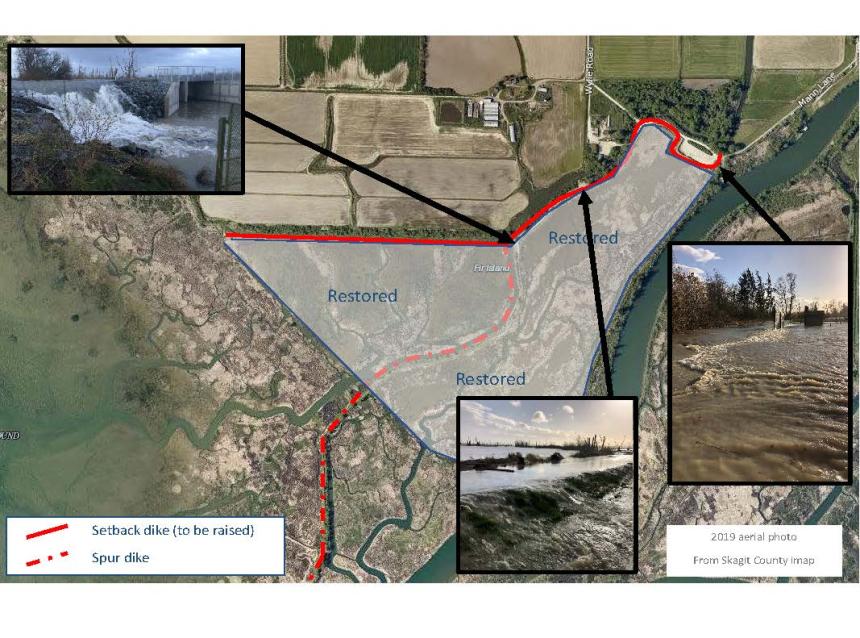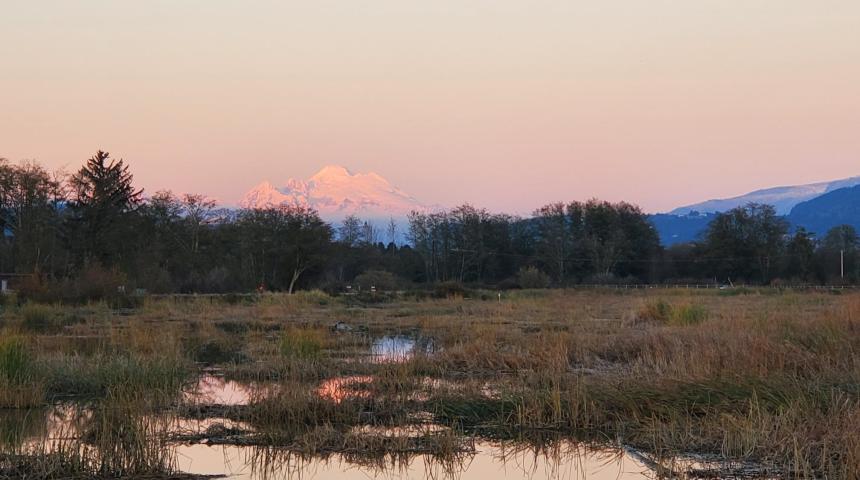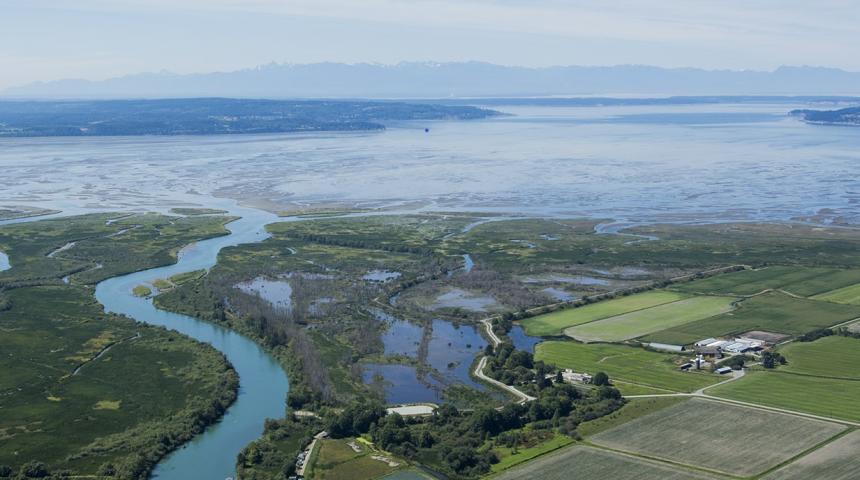- Oct. 10, 2024: WDFW news release: Skagit Wildlife Area Headquarters Unit to reopen Oct. 11. The area—also known as Wiley Slough—is popular for water access, waterfowl hunting, bird watching, and walking and has been closed for construction since spring 2023.
Read all project updates below.
The Wiley Slough Restoration Project, located on WDFW’s Skagit Wildlife Area Headquarters Unit at the mouth of Freshwater Slough in the lower South Fork Skagit River, was completed in 2009. The project setback dikes and levees and relocated a tidegate to restore 156 acres of land that was historically tidal marsh. The project has been very successful for Chinook and provides rearing habitat for hundreds of thousands of juvenile Chinook each year.
The land where the project took place was diked and drained between the late 1930s and the early 1960s. WDFW acquired the site in 1959 and grew cereal grains for waterfowl from the early 1960s until restoration in 2009.
The project goal was to “restore natural estuarine processes, conditions, functions and biological responses” to benefit Chinook and other fish and wildlife, and one of several project objectives was to “provide for agricultural drainage and flood protection.”
The restored habitat is extremely successful for fish, holding and rearing almost 10 times more juvenile Chinook than predicted and supporting over 20 species of fish as well as shorebirds, waterfowl and other species that rely on estuaries. During post-restoration monitoring in 2012 and 2013 over 22,000 fish were caught; representing at least 23 fish species, including seven salmon species.
However, flood and drainage infrastructure has not functioned properly. The setback dike has overtopped six times since 2016 causing damage to the dike, access road and other features on the wildlife area, and flooded neighboring land. More severe or prolonged overtopping could breach the dike and cause large-scale flooding and damages on Fir Island.
In summer 2023, work began to raise the setback dike to a height that will decrease the risk of overtopping and ensure the dike meets Corps of Engineers design guidelines. Raising the dike requires additional widening on the landward side, which will result in some changes to parking, road alignment, and vegetation. These actions will have no impact on the restored estuary habitat.
Fall 2022
Tree and shrub removal along the dike system in fall 2022 was the first step to raise and widen the dikes to reduce overtopping and meet Army Corp of Engineers design guidelines. The footprint of the raised and widened dikes, plus a required 15-foot shrub and tree-free buffer at the toe of certain sections of the dike, was cleared. WDFW staff recognized that if vegetation removal was done in the spring of 2023, it would likely cause greater disturbance to birds that had already begun nesting. It was determined that removing the vegetation in September 2022 would result in less disturbance.
Spring 2023 through summer 2024
Tiger Construction was hired as a contractor to raise and widen dikes on the Skagit Wildlife Area Headquarters Unit near Wiley Sough. Additionally, the boat launch and parking lot was upgraded and reconfigured. This project raised and widened the dikes in accordance with Army Corps of Engineers standards. More information is available in this WDFW statement.
Fall 2024
The work to renovate the Skagit Headquarters Unit of Skagit Wildlife Area, building on the Wiley Slough estuary restoration project, was completed in October 2024. The unit reopened to the public on October 11. Additional information is available in WDFW's news release. The dike will be monitored for the next 2 years to ensure it is meeting established performance criteria.

Project benefits
- Rearing habitat for hundreds of thousands of juvenile Endangered Species Act (ESA) listed Chinook salmon each year.
- Habitat for over 20 fish species, including for juvenile chum, adult foraging habitat for ESA-listed bulltrout and cutthroat trout, and habitat for forage fish such as smelt.
- Habitat for waterfowl, shorebirds, and a host of other birds.
- Continued recreational access.
Project details
Partners involved
For the dike raise project WDFW is partnering with Skagit County Consolidated Diking, Drainage and Irrigation District #22, which manages the flood and drainage infrastructure on Fir Island.
Project design
The estuary restoration project involved removing about 6,500 linear feet of marine dike and river levee, building about 2,850 feet of new setback dike, augmenting about 3,000 linear feet of existing dike, building a new tidegate in the setback dike, and providing recreational access features.
The project raised the dike approximately 3 feet. The dike will also be widened to maintain side-slopes as height increases and to accommodate pullouts and turn-arounds needed during flood fights for dike maintenance. The additional area needed for the expanded dike footprint will be landward of the existing dike, which will require removing vegetation and moving the access road, power poles and a toilet.
Project funding
Funding for the original project in 2009 came from:
- Recreation and Conservation Office (RCO) Salmon Recovery Funding Board
- RCO and WDFW Estuary and Salmon Restoration Program (ESRP),
- Natural Resources Conservation Service (NRCS) Wetland Restoration Program
- U.S. Fish and Wildlife Service (USFWS) National Coastal Wetland Program.
- Seattle City Light
Funding for the dike raise project in 2023-24 came from:
- RCO and WDFW Estuary and Salmon Restoration Program (ESRP)
- Washington State Legislature and WDFW Capital Budget
Environmental review
Federal, state and local permits were needed for the original project and the dike raise project.
Contact
Contact information
For more information, please contact Jenny Baker at Jenny.Baker@dfw.wa.gov or 360-855-8325.
Updates
- Oct. 10, 2024: WDFW news release: Skagit Wildlife Area Headquarters Unit to reopen Oct. 11. The area—also known as Wiley Slough—is popular for water access, waterfowl hunting, bird watching, and walking and has been closed for construction since spring 2023.

